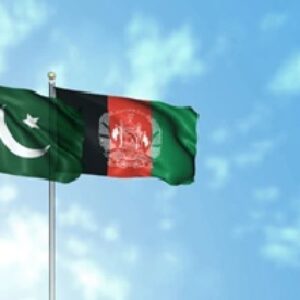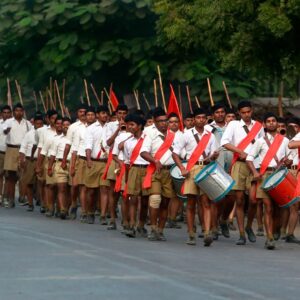What lies at the philosophical core of India’s struggle for freedom from British rule? What were Bankim Chandra Chattopadhyay’s, Vivekananda’s and Aurobindo’s thoughts about the idea of the ‘mother’?
These three men and their idea or image of the ‘mother’ are deeply, indeed irretrievably, intertwined in India’s struggle for freedom against British colonial rule. This has rarely ever been spoken about or studied because of the spiritual connotations of their beliefs but it is impossible to really understand the philosophical underpinnings of the Indian independence movement without understanding the subtle interplay of these philosophies which were most profoundly understood by Mahatma Gandhi and which he used to turn a tired, elite petitioning body, the Congress, into a mass movement for India’s freedom from colonial rule.
The Indian National Movement is seen as a momentous political campaign which concluded with a grand, if pyrrhic, victory with the division of the land.It is often said that the imagination of the nation called India began in 1947 but it was perhaps in a sense the conclusion (and not the beginning) of the original nation imagined, the Bharat of yore, which ended in 1947, breaking up into today’s South Asia.
To understand the spirit of this imagination, then, is to understand the philosophical pillars on which it stood, indeed stands. To contemplate these foundations we could delve into writings of antiquity but for the narrow purpose of this article, I wish to draw a simple, more contemporary straight line connecting the founding philosophies of what a struggle for freedom really means from the publication of Ananda Math to Swami Vivekananda’s 1893 appearance in Chicago and his subsequent short life till 1902, and the teachings of Rishi Aurobindo, who, born as he was in 1872, was in a sense the final inheritor of this philosophical tradition.
Ananda Math, the story of forest-dwelling ascetics, by Bankim Chandra Chattopadhyay, holds within it the seminal song of freedom in India, VandeMataram (the root of the word Vande, that is ‘Vand’, of course, comes from references in the Rig Veda, and it means ‘to pay homage’). In seeing the nation in the form of bounteous mother, it carries within it an ancient liturgical tradition of reverence of the nature, of its munificent gifts, and the worship of sacred geographies. As Harvard’s Diana Eck has reminded us, it is through the footsteps of pilgrims, walking from shrine to shrine, that the ‘civilisational state’ (a term first used by the Chinese scholar Zhang Weiwei in context to China, but which is equally, if not more so, applicable to India) of Bharat was first imagined.
It is VandeMataram that Rabindranath Tagore sang at the 1896 Calcutta session of the Congress. When BikajiCama made the first version of the Indian national flag in Stuttgart in Germany in 1907, it had VandeMataram written in the middle band. LalaLajpatRai started a journal called VandeMataram from Lahore. HiralalSen made India’s first political film in 1905 which ended with the chant. MatanginiHazra’s last words as she was shot to death by the British were VandeMataram.
All of Vivekananda’s references to his country talk about the idea of the mother, taken of course also from the worship of his spiritual master Ramakrishna Paramhansa who sang incessantly to the Mother Goddess Kali. In fact, Vivekananda started the tradition of referring to women as ‘mother’ which continues in the Ramakrishna Mission even today. In a letter from America, Vivekananda writes that when he began to refer to women as mother in the West, a lot of women were astonished, some even offended! But that idea of depiction remained resonant and true. It was the source for sustenance for revolutionaries of that time, including Vivekananda. In 1946, in Guwahati, Mahatama Gandhi urged that “Jai Hind should not replace VandeMataram”. He reminded everyone present that VandeMataram was being sung since the inception of the Congress. He supported the Jai Hind greeting, but suggested that this greeting should not be to the exclusion of VandeMataram.
Vivekananda’s youngest brother, BhupendranathDutta, who turned to militant nationalism, “regarded Vivekananda as one of the direct sponsors of militant nationalism” against the British Raj. Vivekananda himself is known to have said that Bengal was “in need of bomb and bomb alone”. There is also some evidence that Vivekananda wanted to gather and rouse the princely states against the British. He even met ‘Sir Hiram Maxim, the bomb-maker’ to that end but realised that the country was not ready for such an armed revolt against the colonial rule at that time. He told the revolutionary Jyotindranath Mukherjee, aka BaghaJatin, “India’s political freedom was essential for the spiritual fulfillment of mankind”.
Aurobindo is the direct inheritor of this tradition. Not least because his is one of the most famous translations of VandeMataram to English. Little wonder, then, that it is Aurobindo, who wrote so movingly about the Indian Renaissance, gave India and its independence movement the concept, in June 1907, of “legitimate patriotism”.
He said: “If it is patriotic for an Englishman to say, as their greatest poet has said, that this England never did nor shall lie at the proud feet of a conqueror, why should it be unpatriotic and seditious for an Indian to give expression to a similar sentiment? If it is highly patriotic for a Roman “to die in defence of his father’s ashes and the temples of his gods”, why should it be madness and senseless folly for an Indian to be stirred by a similar impulse? If “self-defence is the bulwark of all rights”, as Lord Byron has said, why should an Indian journalist be charged with an attempt to incite violence when he asks his countrymen of East Bengal to defend the honour of their women at any cost? If Campbell is right in saying that virtue is the spouse of liberty, why should an Indian be exposed to the menace of siege-guns when entering on a legitimate and lawful struggle for the recovery of his lost freedom? If each noble aim repressed by long control expires at last or feebly mans the soul, why should not our countrymen benefit by the advice of Goldsmith and begin to chafe at the attempt to prolong this alien control? If Tennyson is justified in taking pride in his country which freemen till, which sober-suited Freedom chose, where girt with friends or foes, a man may speak the thing he will, where freedom slowly broadens down from precedent to precedent, why should it be criminal on the part of an Indian to imagine a similar future for the land of his birth?”
Aurobindo’s spiritual consort, the French ascetic MirraAlfassa, of course took the name of The Mother.
It is, then, my argument that the spirit, indeed the reverberating core, of the Indian National Movement lies in this tale of three mothers as defined by Bankim Chandra Chattopadhyay’sAnanda Math, Swami Vivekananda and Rishi Aurobindo. If you will allow me a humorous aside - as every Indian knows, there is no freedom without the mother.
(This is the summary of the talk delivered by HindolSengupta, Editor-at-large, Fortune India at the national seminar on “Revisiting Indian Independence Moment” organized by India Foundation at New Delhi on 18th March 2017.)
(This article is published in the July-August 2017 issue of India Foundation Journal.)
Listen to this article now
00:00
--:--




